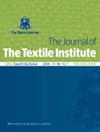基于PVP/PDA的智能纳米纤维静电纺丝在伤口敷料中的应用
IF 1.5
4区 工程技术
Q2 MATERIALS SCIENCE, TEXTILES
引用次数: 0
摘要
摘要本研究以石榴皮(PG)提取物为原料,对聚乙烯吡咯烷酮(PVP)和聚二乙炔(PDA)静电纺丝制备智能抗菌纳米纤维进行了研究。简单地说,首先以两种不同的比例制备了PDA-PVP溶液,并在不同的条件下进行了静电纺丝。基于SEM结果,选择了PDA:PVP纳米纤维的比例为1:3,平均纤维直径为130±40 nm,电纺丝电压为15 kV,加料速度为0.5 ml/h,集电极距离为15 cm的最佳条件。PG的加入使纤维直径增大。由于温度或pH值或暴露于不同溶剂的变化,静电纺纤维的颜色从蓝色变为红色。抑菌试验表明,负载PG提取物的纤维对金黄色葡萄球菌和大肠杆菌均有较高的抑菌活性。MTT实验和细胞贴壁也验证了制备的纳米纤维的生物相容性。因此,所制备的智能聚乙二醇负载纳米纤维在伤口敷料中具有很高的应用潜力。关键词:聚二乙炔聚乙烯吡咯烷酯石榴皮提取物电纺纳米纤维超声敷料披露声明作者未报告潜在利益冲突。本文章由计算机程序翻译,如有差异,请以英文原文为准。
Electrospinning of smart nanofibers based on PVP/PDA for wound dressing applications
AbstractIn the present study, electrospinning of polyvinylpyrrolidone (PVP) and polydiacetylene (PDA) with pomegranate peel (PG) extract was investigated for the preparation of smart and antibacterial nanofibers. Briefly, PDA-PVP solutions were firstly prepared at two different ratios and electrospun under different conditions. Based on the SEM results, the 1:3 ratio of PDA:PVP nanofibers, with an average fiber diameter of 130 ± 40 nm, electrospun at a voltage of 15 kV, feeding rate of 0.5 ml/h and collector distance of 15 cm was selected as the optimal conditions. The addition of PG resulted in an increase in the diameter of the fibers. The color of the electrospun fibers was altered from blue to red due to changes in either temperature or pH or exposure to different solvents. The antibacterial test showed high antimicrobial activity of the fibers loaded with PG extract against both S. aureus and E. coli. MTT assay and cell attachment also validated the biocompatibility of the fabricated nanofibers. Thus, the prepared smart PG-loaded nanofibers had a high potential to be used in wound dressing applications.Keywords: Polydiacetylenepolyvinylpyrrolidonepomegranate peel extractelectrospun nanofiberswound dressing Disclosure statementNo potential conflict of interest was reported by the author(s).
求助全文
通过发布文献求助,成功后即可免费获取论文全文。
去求助
来源期刊

Journal of the Textile Institute
工程技术-材料科学:纺织
CiteScore
4.20
自引率
5.90%
发文量
149
审稿时长
1.0 months
期刊介绍:
The Journal of The Textile Institute welcomes papers concerning research and innovation, reflecting the professional interests of the Textile Institute in science, engineering, economics, management and design related to the textile industry and the use of fibres in consumer and engineering applications. Papers may encompass anything in the range of textile activities, from fibre production through textile processes and machines, to the design, marketing and use of products. Papers may also report fundamental theoretical or experimental investigations, including materials science topics in nanotechnology and smart materials, practical or commercial industrial studies and may relate to technical, economic, aesthetic, social or historical aspects of textiles and the textile industry.
All published research articles in The Journal of The Textile Institute have undergone rigorous peer review, based on initial editor screening and anonymized refereeing by two expert referees.
 求助内容:
求助内容: 应助结果提醒方式:
应助结果提醒方式:


